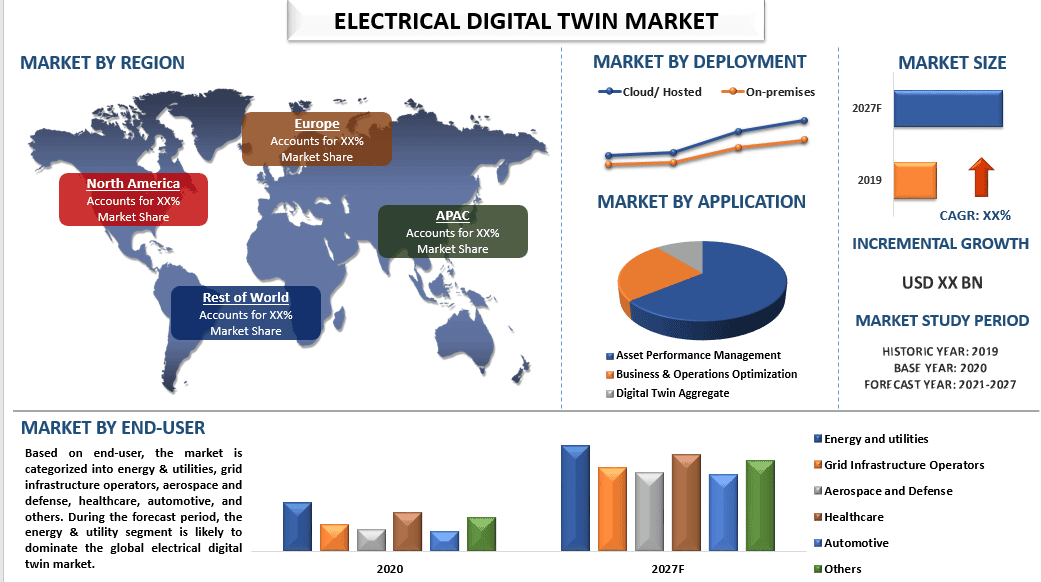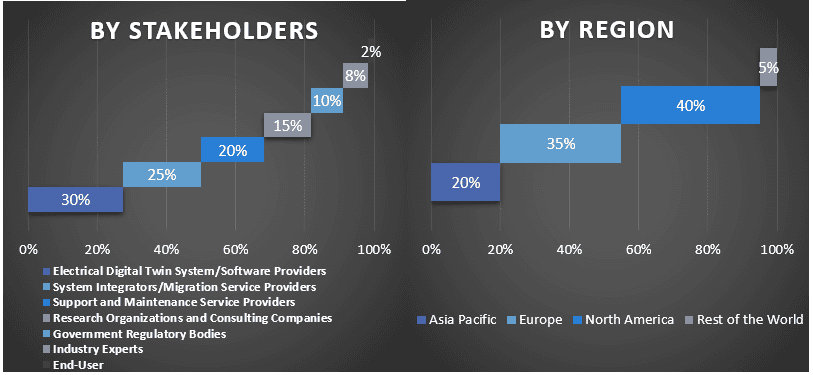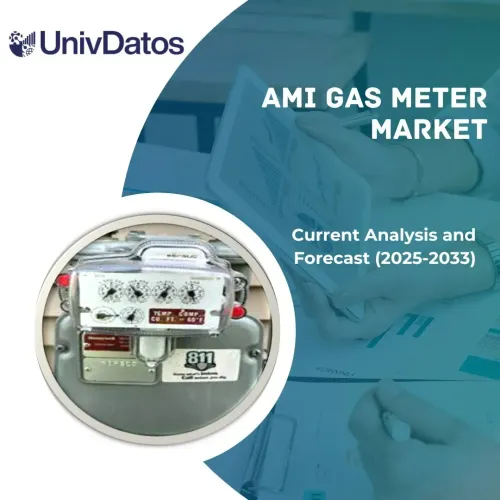- Home
- About Us
- Industry
- Services
- Reading
- Contact Us
Electrical Digital Twin Market: Current Analysis and Forecast (2021-2027)
Emphasis on Usage Type (product, process, and system), Twin Types (Digital Gas & Steam Power Plant, Digital Wind farms, Digital Grid, Digital Hydropower Plant, and Distributed Energy Resources), Application (Asset Performance Management, Business & Operations Optimization, and Digital Twin Aggregate), Deployment (cloud and on-premises), End-User (Energy and utilities, Grid Infrastructure Operators, Aerospace and Defense, Healthcare, Automotive, and Others), and Region/Country

The global electrical digital twin market is expected to witness a CAGR of around 12% during the forecast period (2021–2027). This is mainly due to the increasing R&D initiatives for the development of new technologies coupled with the rising integration and adoption of IoT, AI, and ML technologies in different sectors such as utilities, grid infrastructure, automotive, healthcare, and others. An electrical digital twin is used for the growth of integration of variable renewable energy with the grid and the decentralization of distributed energy resources.
In addition, major players such as GE, Siemens, IBM, SAP, and many others in the market are continuously developing solutions with the electrical digital twin. For instance, In June 2021, Siemens and Threedy collaborated for developing a visual computing platform where Sidrive IQ is providing a visual computing platform instant3Dhub where user access is expected by the integration of Threedy’s visualization service to visual digital twin information.
Electrical digital twin enables utilities to simplify the data maintenance and electrical devices like sensors, and exchange process. Data from different systems are coordinated and then aggregated into a single multi-user database through standards-based adapters or interfaces. A trustworthy single source of data truth is one of the major attributes. As more integrated technologies are incorporated into the digital twin, it becomes more thorough, resulting in a digital thread that standardizes the entire process and produces optimal results. They’re mostly found in healthcare, water supply, automobile industries, and others. Furthermore, the increasing R&D for the Internet of Things (IoT) for energy, utilities, healthcare, aerospace, and automotive coupled with rising government initiatives for the integration of energy-efficient systems and technologies across sectors is expected to drive the market for electrical digital twin during the forecast period.
General Electric, Siemens AG, ABB Limited, Emerson Electric, AVEVA Group, Schneider Electric, SAP, Microsoft Corporation, Wipro Limited, and IBM Corporation are some of the key players in the market. Several M&As along with partnerships have been undertaken by these players to boost their presence in different regions.
Insights Presented in the Report
“Amongst Usage Type, System Digital Twin category to hold a significant share in the market”
Based on usage type, the market is classified as product, process, and system. The system digital twin caters extensive share in the electrical digital twin market and is expected to witness influential growth in the forecasted period as well. A system digital twin is a collection of products and processes that perform a network-wide function and can be used to stimulate those networks such as substations, power plants, wind farms, and distributed energy resources. The system twin provides visibility into a set of interdependent equipment and a connected view of the end-to-end network of assets based on actual operational data.
“Amongst Twin Type, digital gas & steam power plant segment to hold a significant share in the market”
Based on twin types, the market is categorized into digital gas & steam power plant, digital wind farms, digital grid, digital hydropower plants, and distributed energy resources. The digital gas & steam power plant segment is expected to cater to extensive demand in the electrical digital twin market during the forecast period. The power sector operators are planning to induce digital gas & steam power to reduce emissions and fuel consumption of gas & steam turbines asset. It is mainly attributed due to the rising optimization of machines, strategies, health, equipment, and increasing reliability through performance management. However, digital gas and steam power plants have a higher maintenance requirement compared to power generation facilities.
“Amongst Application, Asset Performance Management segment to hold a significant share in the market”
Based on application, the market is categorized into asset performance management, business & operations optimization, and digital twin aggregate. During the forecast period, the asset performance management segment is likely to dominate the global electrical digital twin market. It is mainly due to the increasing requirements for continuous asset monitoring and predictive maintenance in various end-user industries that are positively influencing the market demand for electrical digital twins. It also offers reliability maintenance capabilities and recommends modifications in maintaining strategies for optimal utilization of assets based on budget and reliability risk constraints.
“Amongst Deployment, Cloud Solutions segment to hold a significant share in the market”
Based on deployment, the market is categorized into the cloud and on-premises. During the forecast period, the cloud segment is likely to dominate the global electrical digital twin market. The rising deployment of the cloud is mainly due to its significant requirement across end-user industries, as it offers various advantages such as scalability, adaptability, fewer investment requirements, cost-effectiveness, and low energy consumption. In addition, the cloud segment stores a large amount of data and gives easy access to improve the digitization of the power grid system.
“Amongst End-User, Energy & Utilities are accounted for a significant market share in 2020”
Based on end-user, the market is categorized into energy & utilities, grid infrastructure operators, aerospace and defense, healthcare, automotive, and others. During the forecast period, due to the increased usage of renewable energy and advanced digital technology, the energy & utilities segment is likely to dominate the global electrical digital twin market as it is the prominent end-users of digital twin technology. Several market players such as GE, ABB Limited, Siemens AG, and others are investing in the deployment of electrical digital twins for real-time data analysis and visualizations well as the development of long-term asset management and business strategies to cut operational costs which in turn are positively influencing the market size of the electrical digital twin.
North America to witness significant growth during the forecast period”
North America is expected to witness significant growth in the electrical digital twin market during the forecast period. The major contributors to the growth of this market are developed countries such as U.S. and Canada. The increase in infrastructure development in emerging economies, as well as the expansion of the commercial and industrial sector, coupled with decentralization of distributed energy resources, improved accuracy, and efficiency in power sector operations, are the factors that contributed to the growth of the North America market.
Furthermore, the electrical digital twin market is expected to grow in the forecasted period due to the soaring R&D activities in the realms of the Internet of Things (IoT) as well as the increased need for efficient and cost-effective power utility technologies. Additionally, the growth of digital technologies with a rapid increase in different technologies is seen as well as the upgrading of power generation and distribution infrastructure is also present. IoT applications seem to have more opportunities to improve the standard of living and revolutionize the industrial sector in North America due to the large population as well as growth in the economy.
Reasons to buy this report:
- The study includes market sizing and forecasting analysis validated by authenticated key industry experts.
- The report presents a quick review of overall industry performance at one glance.
- The report covers an in-depth analysis of prominent industry peers with a primary focus on key business financials, product portfolios, expansion strategies, and recent developments.
- Detailed examination of drivers, restraints, key trends, and opportunities prevailing in the industry.
- The study comprehensively covers the market across different segments.
- Deep dive regional level analysis of the industry.
Customization Options:
The global electrical digital twin market can further be customized as per the requirement or any other market segment. Besides this, UMI understands that you may have your own business needs, hence feel free to connect with us to get a report that completely suits your requirements.
Table of Content
Research Methodology for the Global Electrical Digital Twin Market Analysis (2021-2027)
Analyzing the historical market, estimating the current market, and forecasting the future market of the global electrical digital twin market were the three major steps undertaken to create and analyze the adoption of the electrical digital twin in major regions globally. Exhaustive secondary research was conducted to collect the historical market numbers and estimate the current market size. Secondly, to validate these insights, numerous findings and assumptions were taken into consideration. Moreover, exhaustive primary interviews were also conducted, with industry experts across the value chain of the global electrical digital twin market. Post assumption and validation of market numbers through primary interviews, we employed a top-down/bottom-up approach to forecasting the complete market size. Thereafter, market breakdown and data triangulation methods were adopted to estimate and analyze the market size of segments and sub-segments of the industry pertains to. Detailed methodology is explained below:
Seek More Details About Research Methodology
Analysis of Historical Market Size
Step 1: In-Depth Study of Secondary Sources:
Detail secondary study was conducted to obtain the historical market size of the electrical digital twin market through company internal sources such as annual reports & financial statements, performance presentations, press releases, etc., and external sources including journals, news & articles, government publications, competitor publications, sector reports, third-party database, and other credible publications.
Step 2: Market Segmentation:
After obtaining the historical market size of the electrical digital twin market, we conducted a detailed secondary analysis to gather historical market insights and share for different segments & sub-segments for major regions. Major segments included in the report as usage type, twin type, application, deployment, and end-user. Further country-level analyses were conducted to evaluate the overall adoption of testing models in that region.
Step 3: Factor Analysis:
After acquiring the historical market size of different segments and sub-segments, we conducted a detailed factor analysis to estimate the current market size of the electrical digital twin market. Further, we conducted factor analysis using dependent and independent variables soaring R&D activities in the realms of the Internet of Things (IoT) as well as the increased need for efficient and cost-effective power utility technologies. A thorough analysis was conducted for demand and supply-side scenarios considering top partnerships, mergers and acquisitions, business expansion, and product launches in the electrical digital twin market sector across the globe.
Current Market Size Estimate & Forecast
Current Market Sizing: Based on actionable insights from the above 3 steps, we arrived at the current market size, key players in the global electrical digital twin market, and market shares of the segments. All the required percentage shares split, and market breakdowns were determined using the above-mentioned secondary approach and were verified through primary interviews.
Estimation & Forecasting: For market estimation and forecast, weights were assigned to different factors including drivers & trends, restraints, and opportunities available for the stakeholders. After analyzing these factors, relevant forecasting techniques i.e., top-down/bottom-up approach were applied to arrive at the market forecast about 2027 for different segments and sub-segments across the major markets globally. The research methodology adopted to estimate the market size encompasses:
- The industry’s market size, in terms of revenue (USD) and the adoption rate of the electrical digital twin market across the major markets domestically
- All percentage shares, splits, and breakdowns of market segments and sub-segments
- Key players in the global electrical digital twin market in terms of solutions offered. Also, the growth strategies adopted by these players to compete in the fast-growing market
Market Size and Share Validation
Primary Research: In-depth interviews were conducted with the Key Opinion Leaders (KOLs) including Top Level Executives (CXO/VPs, Sales Head, Marketing Head, Operational Head, Regional Head, Country Head, etc.) across major regions. Primary research findings were then summarized, and statistical analysis was performed to prove the stated hypothesis. Inputs from primary research were consolidated with secondary findings, hence turning information into actionable insights.
Split of Primary Participants in Different Regions

Market Engineering
The data triangulation technique was employed to complete the overall market estimation and to arrive at a precise statistical number for each segment and sub-segment of the global electrical digital twin market. Data was split into several segments & sub-segments post studying various parameters and trends in the areas of various usage types, twin types, applications, deployment, and end-user in the global electrical digital twin market.
The main objective of the global Electrical Digital Twin Market Study
The current & future market trends other than the global electrical digital twin market were pinpointed in the study. Investors can gain strategic insights to base their discretion for investment on the qualitative and quantitative analysis performed in the study. Current and future market trends determined the overall attractiveness of the market at a regional level, providing a platform for the industrial participant to exploit the untapped market to benefit from a first-mover advantage. Other quantitative goals of the studies include:
- Analyze the current and forecast market size of the electrical digital twin market in terms of value (USD). Also, analyze the current and forecast market size of different segments and sub-segments
- Segments in the study include areas of usage type, twin type, application, deployment, and end-user.
- Define and analysis of the regulatory framework for the electrical digital twin market industry.
- Analyze the value chain involved with the presence of various intermediaries, along with analyzing customer and competitor behaviors of the industry.
- Analyze the current and forecast market size of the electrical digital twin market for the major region.
- Major countries of regions studied in the report include Asia Pacific, Europe, North America, and the Rest of the world.
- Company profiles of the electrical digital twin market and the growth strategies adopted by the market players to sustain in the fast-growing market
- Deep dive regional level analysis of the industry
Related Reports
Customers who bought this item also bought










